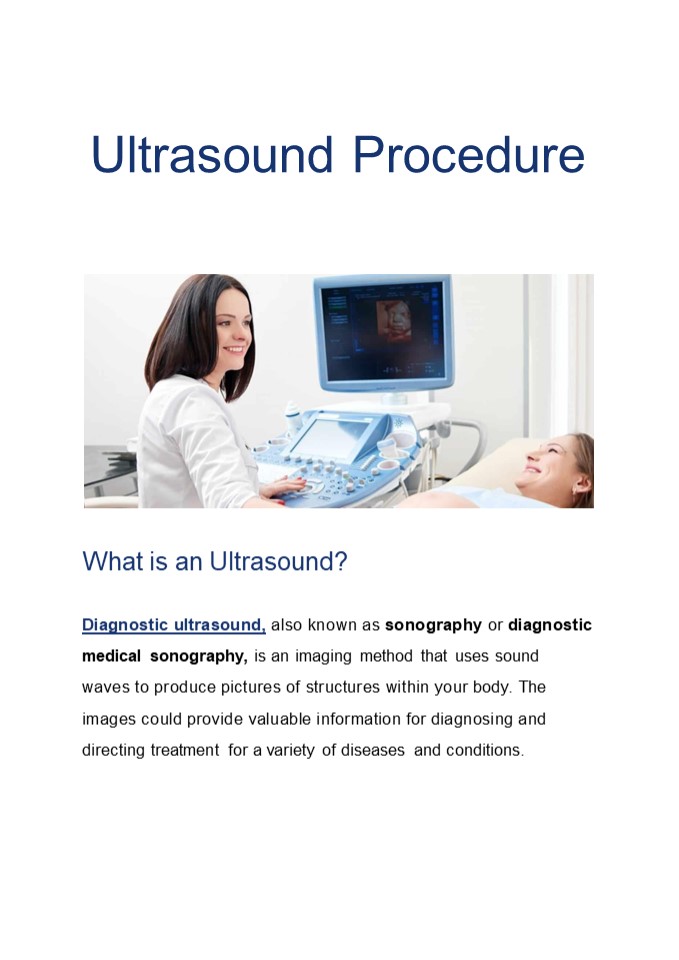Ultrasound - Procedure, Preparation and Risk PowerPoint PPT Presentation
Title: Ultrasound - Procedure, Preparation and Risk
1
Ultrasound Procedure
What is an Ultrasound?
Diagnostic ultrasound, also known as sonography
or diagnostic medical sonography, is an imaging
method that uses sound waves to produce pictures
of structures within your body. The images could
provide valuable information for diagnosing and
directing treatment for a variety of diseases and
conditions.
2
Most ultrasound examinations are done using an
ultrasound device outside your body, though some
involve placing a tiny device inside your body.
Why it is done
Ultrasound is used for a number of reasons,
including to Observe the uterus and ovaries
during pregnancy and monitor the developing
baby's health Diagnose gallbladder disease
Evaluate blood flow Guide a needle for biopsy or
tumor treatment Examine a breast lump Check the
thyroid gland Find genital and prostate problems
Assess joint inflammation (synovitis) Evaluate
metabolic bone disease
3
Ultrasound Risks
Diagnostic ultrasound is a low-risk procedure
that uses low-power sound waves. There arent
any known risks. Ultrasound is a valuable tool,
but it has restrictions. Sound waves do not
travel well through air or bone, so ultrasound is
not effective at imaging body parts that have
gas in them or are hidden by bone, like the
lungs or head. Ultrasound might also be unable to
see objects that are located very deep in the
human body. To view these areas, your health
care provider might order other imaging tests,
such as CT or MRI scans or X-rays.
4
Ultrasound Preparation
Most ultrasound examinations require no
preparation. However, there are some
exceptions For some scans, such as a
gallbladder ultrasound, your care provider might
ask that you not eat or drink for a certain
period of time before the examination. Others,
such as a pelvic ultrasound, might require a full
bladder. Your doctor will let you know how much
water you need to drink before the examination.
Do not urinate until the examination is
done. Young children might need additional
preparation. When scheduling an ultrasound for
yourself or your child, ask your doctor if there
are any specific instructions you will need to
follow. Clothing and personal items Wear loose
clothing for your ultrasound appointment. You
might be asked to remove jewellery during your
ultrasound, so it is a good idea to leave any
valuables at home.
5
What you can expect
Before the procedure Before your ultrasound
begins, you might be asked to do the
following Remove any jewellery from the region
being examined. Remove or reposition all or a
portion of your clothing. Change into a
gown. You will be prompted to lie down on the
examination table.
6
During the procedure The gel is applied to your
skin over the region being examined. It helps
prevent air pockets, which can block the sound
waves that create the pictures. This safe,
water-based gel is easy to remove from skin and,
if needed, clothing. A trained technician
(sonographer) presses a small, hand-held device
(transducer) against the region being studied and
moves it as needed to capture the images. The
transducer sends sound waves into your body,
collects the ones that bounce back, and sends
them to a computer, which creates the
pictures. Sometimes, ultrasounds are performed
inside your body. In this case, the transducer
is connected to a probe that is inserted into a
natural opening in your body. Examples include
7
Transesophageal echocardiogram - A transducer,
inserted into the oesophagus, obtains heart
pictures. It is usually done while under
sedation. Transrectal ultrasound - This test
creates pictures of the prostate by placing a
special transducer into the rectum. Transvaginal
ultrasound - A special transducer is gradually
inserted into the vagina to look at the uterus
and ovaries. Ultrasound is generally painless.
However, you might experience mild discomfort as
the sonographer guides the transducer over your
body, particularly if you are required to have a
full bladder, or inserts it into your body. A
typical ultrasound examination takes from thirty
minutes to an hour.
Ultrasound Results
When your examination is complete, a doctor
trained to interpret imaging studies
(radiologist) analyzes the pictures and sends
a report to your doctor. Your doctor will let you
know about the results. You should be able to
get back to normal activities immediately after
an ultrasound.
8
When your examination is complete, a doctor
trained to interpret imaging studies
(radiologist) analyzes the pictures and sends
a report to your doctor. Your doctor will let you
know about the results. You should be able to
get back to normal activities immediately after
an ultrasound. Hill Regional (HRH) Hospital is
here to assist with all your medical needs with
specialists and surgeons trained and experienced
in the most advanced treatments. Our highly
qualified doctors, nurses, and administrators
are dedicated to caring for you with compassion
in our state-of-the-art facilities. Call us on
254-580-8500 to book an appointment with our
specialist doctors.

